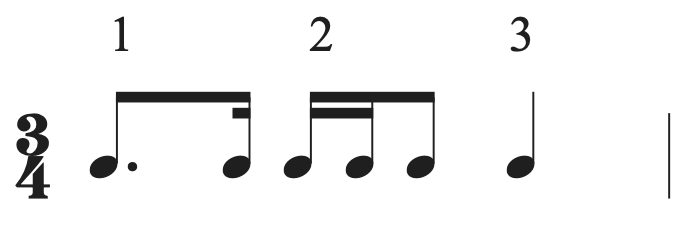1.3 Basics of Beaming: Tutorial
Beaming
Rhythms in music are beamed according to the meter. Notes that are part of each beat are organized so that they are together. Beaming the notes that make up one beat serves as a visual guide in the music. Correct beaming makes it easy to see how many beats are in the bar, makes it easier to identify a meter, and makes it easier to read music quickly. Beaming music incorrectly makes rhythms hard to understand and read.
How to Beam Rhythms According to the Meter
Changing the beaming of rhythms doesn’t change the duration of the rhythms, but changes how they are organized within each beat. Look at the incorrectly beamed example below.

Start by labeling the number of beats in the bar so that the rhythms can be organized to fit into each beat.
 Beat 1 starts with a dotted eighth note, which is not long enough to fill beat 1, so we need identify what note is needed in order to complete the beat. A sixteenth note added to that dotted eighth note would complete the beat, so we separate the two sixteenth notes that follow the dotted eighth and beam the first sixteenth note to the dotted eighth note to complete beat 1. This leaves a sixteenth note left over that we can start with to build beat 2.
Beat 1 starts with a dotted eighth note, which is not long enough to fill beat 1, so we need identify what note is needed in order to complete the beat. A sixteenth note added to that dotted eighth note would complete the beat, so we separate the two sixteenth notes that follow the dotted eighth and beam the first sixteenth note to the dotted eighth note to complete beat 1. This leaves a sixteenth note left over that we can start with to build beat 2.

We now have a sixteenth note on beat 2, which is too small to fill beat 2. We need to look at the rhythms that come next and add on to beat 2 until we fill beat 2. The first sixteenth note plus the sixteenth note and eighth note that follow would complete the beat, so we beam them all together to form beat 2.

We are left with 2 eighth notes tied together as our last rhythm. Two eighth notes will be enough to fill beat 3, but instead of writing them as 2 separate eighth notes, we can write a quarter not to make that easier to read.

Let’s compare the original example with the correctly beamed version. The correctly beamed version is clearly easier to read because all 3 beats are easy to identify quickly, and because beaming it correctly uses expected, standard rhythmic patterns.


Bringing Theory to Life
Take a look at the beaming used in the music you are currently playing, or want to learn more about. Does it reflect the meter in a way that is easy to read, or is something beamed ineffectively? Select a tricky passage from your music and re-beam it to make it not reflect the meter. Did that increase the level of difficulty of the music? Making something harder is a great practice technique when learning a tricky passage in music. Once you practice it in the harder version, going back to playing it as written will make the passage seem easy!

